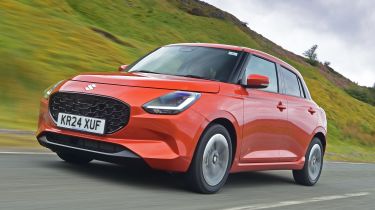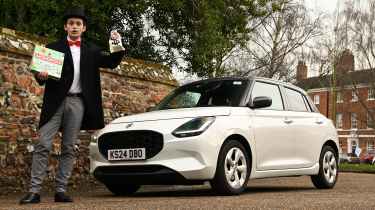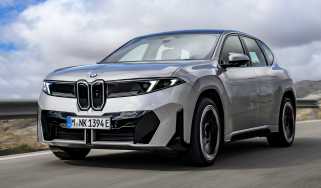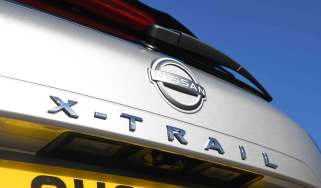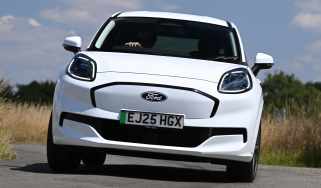Suzuki Swift review
The Suzuki Swift continues to offer plenty of value and efficiency in a dwindling supermini market

Our opinion on the Suzuki Swift
The Suzuki Swift continues to champion the case for small cars in a slowly shrinking class. It feels built to a price in a way the MG3 doesn’t, but the trade-off is a lightweight construction that provides agile handling and rock-bottom fuel costs. The Swift won’t suit everyone, but if you’re not yet ready to go electric, this car provides an affordable, familiar and honest entry into the small-car market.
| Key specs | |
| Fuel type | Petrol |
| Body style | Supermini |
| Powertrain | 1.2-litre, 4cyl, petrol plus MHEV, front-wheel drive 1.2-litre, 4cyl, petrol plus MHEV, four-wheel drive |
| Safety | Three-star Euro NCAP (2024) |
| Warranty | 3yrs/60,000 miles (up to 7yrs/100k miles with routine franchise dealer servicing) |
About the Suzuki Swift
The supermini segment is dwindling. The Ford Fiesta is no more, and fewer manufacturers are finding reasons to invest funds in small cars – looking to more profitable SUVs (and electric cars) instead.
But instead of pulling the plug, Suzuki sees this as an opportunity. It estimates that of the 250,000 superminis sold annually in the UK, almost a third either won’t exist at all, or won’t have a like-for-like petrol replacement by 2028.
Hopes are high for the Suzuki Swift, then. There’s an expectation from the company that the Swift should thrive in a thinning market thanks to a long specification list, respectable efficiency from its mild-hybrid engine, a choice of manual or automatic gearboxes and even a four-wheel drive powertrain option.
All Swifts are powered by a 1.2-litre petrol engine with mild-hybrid electrical assistance, delivering 81bhp and 112Nm of torque. It comes with either a five-speed manual, or a CVT automatic transmission. The majority of the range is front-wheel drive, but the top-of-the-range Ultra trim can be had with ALLGRIP four-wheel drive.
Used - available now

2021 Suzuki
Swift
12,437 milesAutomaticPetrol1.2L
Cash £14,700
2021 Suzuki
Swift
17,941 milesManualPetrol1.2L
Cash £11,076
2014 Suzuki
Swift
40,240 milesManualPetrol1.2L
Cash £6,173
2021 Suzuki
Swift
12,363 milesManualPetrol1.2L
Cash £11,767Speaking of trims, there is a choice of two: entry-level Motion or Ultra. We reckon that Motion makes the most sense because despite being the least expensive version, it still comes stacked with the essentials (and more besides). For instance, there are LED headlights, a nine-inch touchscreen infotainment system with sat-nav and full wireless smartphone connectivity, heated front seats, blind spot monitoring, rear cross-traffic alert, and adaptive cruise control.
The pricier Ultra trim gets a few additional extras such as an automatic climate control system with a rear air vent, polished 16-inch alloys, electrically folding door mirrors, and seatbelt height adjusters.
It’s a car built with budget firmly in mind, but pricing for the Swift actually starts at around £1,000 above the entry-level Renault Clio, while upgrading to Ultra trim ups the Suzuki’s price much closer to that of the entry-level Skoda Fabia.
Suzuki Swift prices and latest deals
Performance & driving experience
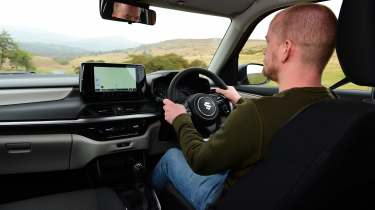
|
Pros |
|
| Cons |
|
The Swift features some very trick construction that means it’s just about the lightest car in the supermini class, with even the 4x4 AllGrip model weighing less than 1,100kg. The front-wheel drive models are even lighter under 1,000kg.
The 81bhp offered by the 1.2-litre Dualjet motor sounds small by modern standards, but the Swift's light kerb weight means that it still feels somewhat enthusiastic. However, in order to get the most out of this engine, carefully timed gear changes are required, so those who stick with the standard five-speed manual gearbox will get an arm and leg workout in hilly areas and while driving around town. Mercifully, the gearbox and clutch are forgiving to use, if a bit vague.
The rest of the basics feel pleasant enough, too. The steering doesn’t do a hot hatch-level job of communicating what the front wheels are doing, but it’s nicely weighted and consistent, making it relatively easy to place the Swift in corners.
The relative lack of mass means the Swift feels pretty agile. The car is happy to change direction quickly, and it stays admirably flat in corners. Unique to the class is the AllGrip all-wheel drive system available on Ultra models, which offers extra traction and security.
The 4x4 model is affordable to buy, and it’s just about rugged enough to take on some lighter off-roading duties, such as tackling snowy conditions or a muddy track. However, the demand for this in the UK is pretty limited, so we can’t really see the point of forking out extra for this over the front-wheel drive car. It’s also worth noting that this variant is only available with a manual gearbox. If you prefer an automatic, you’ll need to go for a front-wheel drive Swift. These cars come with the option of a CVT transmission, but this will cost you over £1,200 more than the manual.
Regardless of your chosen transmission, compromised ride quality is the big trade-off for the Swift’s agility. Suzuki’s engineers reportedly spent time developing the Swift on UK roads, but it hasn’t quite paid off. For the most part, it stays composed, but over broken surfaces – precisely the sort of bumps and potholes that are common on British B-roads, in fact – it gets a bit unsettled. In particular, passengers in the rear are likely to complain about being bounced around, a result of the car’s relatively simple torsion-beam rear suspension set-up and low weight.
Mild-hybrid technology for the 1.2-litre engine utilises a lithium-ion battery that harnesses regenerative braking energy to power a small integrated generator. This, in turn, helps the petrol engine when you’re accelerating, but the goal is efficiency rather than performance, so it never feels like an extra surge of pace. It’s impressively well integrated, but the Swift still very much feels like a modestly-powered combustion car to drive.
Performance, 0-60mph acceleration and top speed
The 1.2 Dualjet petrol unit produces 81bhp and 112Nm of torque. So, to put it bluntly, it isn’t exactly a powerhouse. Opting for four-wheel drive results in the slowest 0-62mph time of the line-up at a very lethargic 13.6 seconds. The manual front-wheel-drive car trims this time ever so slightly to 12.5 seconds. Perhaps surprisingly, the quickest Swifts are those fitted with the CVT auto ‘box. These are capable of the same sprint in 11.9 seconds.
The past three generations of Swift had a Swift Sport variant, which offered significantly more power and performance-oriented engineering tweaks. However, this model has been axed for the current generation. The front-wheel drive Swift with a CVT auto gearbox is the fastest Swift, boasting a top speed of 106 mph. Opting for the manual gearbox reduces the top speed to 103mph, while the four-wheel drive model achieves only 99mph. This means hot hatch fans will now have to look elsewhere (or at least at older used Swift Sports) for thrills.
Town driving, visibility and parking
The Swift’s small stature, light controls and decent all-around visibility make it a breeze to zip around town in. A rear-view camera is included as standard, which helps with parking, but you shouldn’t find yourself too dependent on it (which may be a good job because it’s a bit low-resolution by today’s standards).
B-road driving and handling
It’s on the B-roads where the Suzuki’s light kerb weight comes into its own. While it takes a little while to get up to speed on straight sections, corners can be tackled at higher speeds than this docile supermini’s appearance suggests. As we’ve mentioned, the trade-off is compromised ride quality, but you can at least have a little bit of fun if you want to.
Motorway driving and long-distance comfort
Due to its small size, the 1.2-litre engine requires a fair amount of stoking to reach and maintain motorway speeds. There’s an amusing growl when you put your foot down, but this is soon drowned out at higher speeds due to tyre roar. Unless you have a high level of tolerance for ambient noise, we doubt you’ll want to frequently tackle long trips in this particular car.
| Model | Power | 0-62mph | Top speed |
| Mild Hybrid Motion (manual) | 81bhp | 12.5s | 103mph |
| Mild Hybrid Ultra (CVT) | 81bhp | 11.9s | 106mph |
| Mild Hybrid Ultra AllGrip | 81bhp | 13.6s | 99mph |
“The Swift’s lightweight build does make it feel incredibly nimble, and after being in too many two-tonne EVs it’s refreshing to drive a supermini that doesn’t weigh the same as an adult hippopotamus. The steering is light, too, and its precision makes it easy to zip around through traffic.” - Tom Jervis, consumer reporter.
MPG & running costs
|
Pros |
|
| Cons |
|
A combination of a low kerb weight and an effective mild-hybrid powertrain means the Suzuki Swift has a low thirst for fuel. Officially, the least economical model (the AllGrip Ultra) will return 57.6mpg on the WLTP combined cycle, which is still very far from being thirsty.
The best performer is the front-wheel drive Swift with the manual gearbox, because this returns a claimed 64.2mpg. Fitting the CVT automatic reduces this figure ever so slightly to 60.1mpg.
Manufacturer claims are one thing, but the real-world economy can often be very different, as our road testing has proved on numerous occasions. The good news here is that our long-term Suzuki Swift Hybrid Motion manual delivered close to 60mpg during its time with us, which isn't far off the official figure.
The mild-hybrid technology also helps keep CO2 figures under control, with the entire lineup ranging from 99 to 110g/km.
| Model | MPG | CO2 | Insurance group |
| Mild Hybrid Motion (manual) | 62.4mpg | 99g/km | 21D |
| Mild Hybrid Ultra (CVT) | 60.1mpg | 106g/km | 21D |
| Mild Hybrid Ultra AllGrip | 57.6mpg | 110g/km | 20D |
Insurance groups
Ratings for the Suzuki Swift are surprisingly high, with all models sitting in groups 20-21. This isn’t quite as high as the similarly priced MG3, though, which resides in groups 23-24. However, the pricier Skoda Fabia goes as low as group 4.
An explanation for the Suzuki’s high ratings could be the relatively small number of the brand’s dealers and repairers in the UK, as well as the hassle of sourcing parts for the Swift from Japan if you have an accident.
Tax
The Suzuki Swift is liable for the standard rate of VED road tax, but luxury car tax won’t be an issue even if you go for the highest spec trim level. Company car buyers won’t receive any Benefit-in Kind (BiK) breaks here, because they’ll need a fully electric car in order to reap the savings of the lowest BiK rates.
Depreciation
Our expert data predicts that the Suzuki Swift line-up will retain around 53 to 55 per cent of its initial value after three years and 36,000 miles of ownership. This is a similar performance to the MG3, which holds on to 51 to 55 per cent.
To get an accurate valuation on a specific model check out our free car valuation tool...
Interior, design & technology
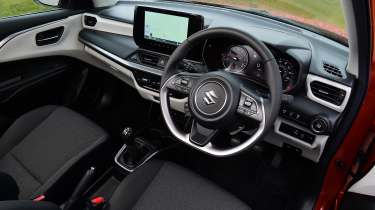
|
Pros |
|
| Cons |
|
If there’s one area of the Swift that highlights Suzuki’s cost-cutting, it’s the interior. While it’s reasonably bright inside, the cabin is a plethora of low-rent materials. It’s not horrific to behold, but there are very few surfaces that aren’t hollow and scratchy to the touch.
Our long-term test car has revealed some build-quality concerns, too, as some interior trim worked its way loose after only putting 1,000 miles on the odometer.
In an attempt to counteract this less-than-luxurious atmosphere, Suzuki has adorned the Swift with a pretty lavish helping of standard equipment. All trim levels get adaptive cruise control, a reversing camera, wireless Apple CarPlay and Android Auto, keyless entry and start and all-round electric windows.
Those who are willing to spend a bit more on the range-topping Ultra trim will also get 16-inch alloy wheels, automatic air-con, adjustable front seatbelts, electronically folding door mirrors and some interior design tweaks.
Interior and dashboard design
The interior design is pretty straightforward, and all of the controls are in sensible-enough positions. One upside of the Swift’s slightly dated design is physical climate control switches, which are far more ergonomic and easy to use than frustrating touchscreen sub-menus or haptics.
Another area that makes the Swift feel a bit long in the tooth is the dashboard. Analogue dials feature here rather than a digital driver’s display, although there is a small information screen in between the two. While it could never be called fancy, it all does the job and is clear enough to read.
Materials and build quality
As we’ve mentioned, our long-term test car managed to shake its centre console loose after only 1,000 miles of driving. Elsewhere, the interior plastics don’t instil too much confidence either, as many look and feel rather brittle.
While it’s certainly unfair to expect champagne luxury for this lemonade price, other cheap cars, such as the Dacia Sandero, do feel more solidly screwed together than the latest Swift.
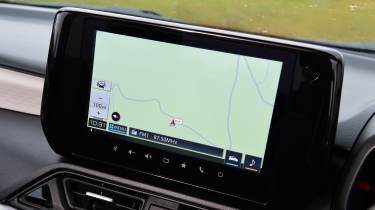
Infotainment, sat-nav and stereo
All Swifts are fitted with a nine-inch touchscreen infotainment system, and this features wireless Apple CarPlay and Android Auto. You’ll probably want to use these smartphone mirroring systems, too, because the brand’s own software feels dated.
While the screen is big enough to display a decent amount of information without cramming it in, the system is slow to respond to input. The graphics are far from cutting-edge, either, and navigating the menus and functions isn’t a very easy task without some practice and patience.
“I’ve been making use of the standard-fit Apple CarPlay to avoid using Suzuki’s own infotainment as much as possible. The system feels antiquated and there’s little to delve into other than sat-nav, radio and efficiency stats, while the graphics are gloomy. Then you’ve got the display itself, which can be lethargic in responding to inputs and lacks contrast.” - Tom Jervis, consumer reporter.
Boot space & practicality
|
Pros |
|
| Cons |
|
Many superminis are used as two-seaters, in effect, with the rear cabin often being used as a dumping ground for shopping rather than as a space for passengers. If this is your pattern of use, the Swift shouldn’t disappoint.
The Swift’s boot is usable at 265 litres, but this lags well behind rivals like the, which MG3 has 293 litres, while the Skoda Fabia offers a whopping 380.
| Dimensions | |
| Length | 3,860mm |
| Width | 1,735mm |
| Height | 1,495mm (standard)/1,520mm (AllGrip) |
| Number of seats | 5 |
| Boot space | 265-589 litres |
Dimensions and size
The latest Swift sits on the same underpinnings as the previous model, and it has only gained a minimal 20mm in length.
As a result, the Swift still has truly compact dimensions compared to some of its rivals. To give you an idea, Suzuki’s supermini is more than 300mm shorter in length than the Skoda Fabia.
Driving position, seats & space in the front
The Swift’s diminutive size naturally means there are some restrictions in terms of head and legroom, but two adult passengers should still be able to sit in reasonable comfort. The driving position is also pretty standard, provided you aren’t accustomed to a sportier, low-slung stance.
Seats & space in the back
Four adults will be able to fit, but taller passengers will become a bit fidgety in the back, especially during a longer journey. Head and legroom are pretty good, but the seat bases provide minimal thigh support, and there isn’t much room under the seats in front to slot your feet under.

Boot space
Many superminis are managing to surpass the 300-litre mark when it comes to boot space, but the Swift still lags behind with a grand total of 265 litres with the rear seats in place.
Folding the 60/40 rear seats opens up 589 litres for the occasional big tip run, but it’s still not about to double up as a small van.
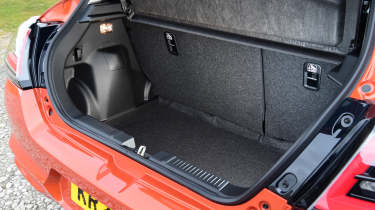
“As soon as you lift the tailgate, you’ll notice that the boot floor is very low. Without this, the Swift’s luggage capacity would be even less, so it's necessary, but you will find yourself reaching quite far down at times, which isn't ideal if you're picking up something heavy.” - Shane Wilkinson, senior content editor
Reliability & safety
|
Pros |
|
| Cons |
|
While Suzuki does throw in the likes of blind-spot monitoring, traffic sign recognition, parking sensors and a driver-monitoring system as standard, the Swift only managed a rather poor three-star rating when it was tested by Euro NCAP in 2024.
For comparison, similarly priced small EV rivals like the Hyundai Inster and Renault 5 both got more respectable 4-star scores when tested under the same criteria.
The Swift is yet to appear in our Driver Power best car to own rankings, but the brand’s 9th-place appearance in our most recent 2025 best manufacturer table is a considerable improvement on the brand's 19th-place finish in 2024. Owners praised the safety systems of their cars, and were also pleased with ride and handling, braking, road manners, and the steering. They were less pleased with the infotainment system, though.
Some good news, though, is that Suzuki’s basic three-year/60,000-mile warranty can be extended up to ten years or 100,000-miles. You will need to have your car serviced annually by a Suzuki-approved workshop, though. If you’re buying brand-new, Suzuki includes a free health check when the car reaches 2,000 miles. A year’s breakdown cover is also thrown in, but this isn’t as generous as Renault’s three-years.
| Key standard safety features |
|
| Euro NCAP safety ratings |
|
Buying and owning
Our best buy: Suzuki Swift Hybrid Motion
The Suzuki Swift will appeal to those who just want a small urban runabout that’s well-equipped and easy to park, and to those who feel small cars have become far too bloated. That lack of excessive mass does pay dividends on a B road, too, where the Swift will earn the respect of those who value something that’s amusing to drive.
We see little point in paying out for the AllGrip four-wheel drive system unless you find yourself in a situation where you often need to drive your supermini in snowy or slippery conditions. For the vast majority of people, the front-wheel drive car will suffice. Unless you really want the cosmetic enhancements of the Ultra trim (and are willing to pay for them), we think there’s enough useful kit included on the entry-level Motion model.
Suzuki Swift alternatives
Unfortunately, the Swift is too noisy inside to be a very good road trip car, so anyone looking for a premium-feeling small car will have to head towards a Skoda Fabia or Volkswagen Polo.
Of course there’s also our favourite small car, the Renault Clio, which sort of does everything you could ask of a small car, yet has lower insurance costs than the Swift, and, in some trims, actually costs less than a Swift.
Company car drivers looking for the lowest tax bill should gravitate towards electric alternatives like the Hyundai Inster, Renault 5, or BYD Dolphin.
Deals on the Swift and alternatives
Suzuki Swift Hybrid Motion long-term test
Consumer reporter, Tom Jervis, ran an entry-level Suzuki Swift Motion as part of an Auto Express long-term test, and found the little Swift to be very frugal on fuel. He never saw less than 40mpg, and averaged nearer to 60mpg overall, which he worked out would save him a tidy sum over a year compared with the MG3 hybrid that was also being run at the time by our News reporter, Ellis Hyde.
However, not all was rosy with Tom's experience, because some interior trim came loose after only 1,000 miles, and he found out the car's high insurance group rating would translate into higher running costs compared with rivals. The latter would be problematic because a driver managed to damage our lovely Swift while parked in a car park and didn't leave Tom a note... You can read the full long-term test here…
Suzuki Swift pictures
Frequently Asked Questions
If fuel efficiency and darty handling are what you’re after in a supermini, then the Suzuki Swift will fit the bill. However, there are much more practical, refined, and nicely finished small cars out there.
New & used Suzuki Swift deals
